|
|
 
|

Here is our catalogue of computer based art we can recommend. You'll find net art, software art, classics, and a continuously updated list of new pieces. Editors: Kristine Ploug & Thomas Petersen. Contact the editors at: artificial at artificial dot dk. Updates and ideas are most welcome.

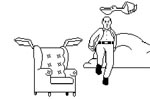 |
Fly Guy
In this monochrome, pixelated art piece by Trevor Van Meter you control a man flying around in a rather absurd universe of flying lounge chairs. While moving about you listen to calm, suiting music. /KP |
 |
The Dumpster
Golan Levin's The Dumpster (made together with Kamal Nigam and Jonathan Feinberg) has collected a huge amount of break-ups from millions of blogs. The Dumpster has an extensive interface allowing you to see similarites and differencies in all the romantic drama. The organic-like bubbles makes it quite neat. Lev Manovich has written an article about this kind of social data. Read it here. /KP |
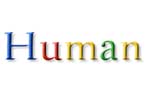 |
Human Browser
Christophe Bruno's Human Browser was shown at this year's Transmediale. The work consist of a person wearing ear phones where synthetic speech is reading out what someone else is browsing on the internet. See the video clippings from Transmediale here. /KP |
 |
Le Nu/The Nude
The naked body as artistic subject matter has been revisited and reinterpreted as nothing else. As a digital spectacle, the body has long since conquered the internet as porn permeated the digital sphere. The French site incident.net presents a series of artistic examinations of the body in a digital context. /TP
|
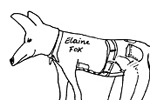 |
Illustrated Spam
Even though some of the text in this project is in Danish Language, it is quite easy for other people to understand. Lotte Skadborg Hansen/afnitp illustrates the patterns in the senders of spam mails - people called Elaine Fox, Miriam Fish, Eve Bird and the like. /KP
|
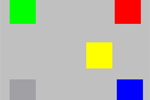 |
Proto_gabber 3.11
In Proto_gabber 3.11 by Dutch artist Peter Luining you can move the five squares. The motions are recorded and each square continues repeating it, generating patterns of motion as well as sound. Neat in all its simplicity. /KP
|
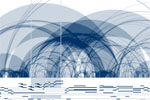 |
The Shape of Song
What does music look like? Martin Wattenberg’s The Shape of Song is a qualified attempt to visualize and compare the structures of music pieces. Wattenberg's piece displays musical form as a sequence of translucent arches giving new perspectives on everything from AC/DC to Wagner. The Shape of Song was shown at the Generator.x exhibition in Oslo, Norway. /TP |
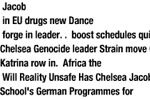 |
PoemeDada RSS v.1
PoemeDada creates poetry out of RSS feeds from news sources. The inspiration is taken from the 20's avantgarde and its automatic poetry, but instead of trying to make people write from their own free association, this piece uses feeds. You can either choose random and have the work generate poetry for you, or you can partipate yourself by organising the words chosen from the feeds. PoemeDada is created by Robin Stein. /KP |
 |
Scream
Obviously, you have always been able to scream at your computer but with Amy Alexander's software art piece, Scream, the computer actually hears it - and responds. You install the scream feature on your computer and using a microphone you get to yell at the computer. It complicates working and listening to online radio but try to play it a song and it will create an interesting, real time desktop music video. /KP |
 |
Park
An oddly intriguing game-like environment by American artist Patrick Smith. The universe unfolds much like a point-and-click game, but has no apparent goals other than exploring a small world in your own time. Really worth immersing yourself into. /TP
|
 |
Amaztype
Using Amazon's web service, Japanese artists Keita Kitamura and Yugo Nakamura let you search for books typographically. The books are presented to you with a picture of their cover and layed out shaping the word you searched for. The beauty of it is that you can actually zoom in and see the covers + info about the books. Also, check out the Amaztype Zeitgeist - a listing of the search trends in Amaztype. /KP |
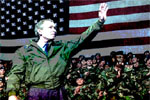 |
One Word Movie
As many other pieces, this one by Swiss artists Beat Brogle & Philippe Zimmermann is fueled by real time Google searches. This particular piece distinguishes itself by its simplicity and clarity. Type one word and this piece will generate a hypnotic sequence of images in interwoven loops. A personal favorite is ‘Antichrist’ (left image). /TP |
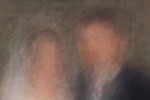 |
100 Special Moments
American artist Jason Salavon uses software processes to present new perspectives on familiar situations. 100 different photos of the same type of special occasion (e.g. wedding photos) are digitally fused to make an ‘average' image i.e. all the images in one. The result gives a surprising perspective on seemingly unique moments. /TP |
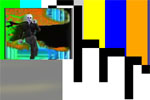 |
Screenfull.net
‘We'll crash your browser with content', Jimpunk and Abe Linkoln claim at their insane blog explosion Screenfull.net (aka ‘stadium rock net art'). It certainly seems possible... Keep an eye on this daily updated page and go for a browse through the archives. /TP |
 |
Giant Steps
Israeli artist Michal Levy's impressive animation is a 3d visualization of John Coltrane's jazz classic 'Giant Steps' from 1959. The music is used as the base for the construction of an virtual architectural space and results in a colorful visual analysis of sound. /TP |
 |
Average
Shoveler
Carlo Zanni's Average Shoveler uses the aesthetic
from the 80s computer game Larry. The work itself (commissioned
by Rhizome.org)
consists of a guy shoveling snow. The snowflakes contain
real time news (images + text) and the guy keeps shoveling
and shoveling to stay on top ... /KP
|
 |
Dreamlogs
Ever since we saw French artist Christophe Bruno's presentation of the project Dreamlogs at Read_me in Aarhus, we have been waiting impatiently for it to come out. Here is a test release of the project described as an 'idea association engine
proposing another way to surf on the internet by disentangling the discourses that have interlaced over time.' /TP |
 |
CyberZoo
CyberZoo by Argentinean artist Gustavo Romano is a virtual zoo making it possible to experience the wildest expressions of artificial life. It is a kind of preservation strategy for endangered digital species such as viruses, worms etc.
/TP
|
 |
Untitled Game
Jodi's modifications of the mainstream game Quake rip the game apart and reassemble the rubble into a number of abstract, dysfunctional and haunting digital spaces leaving very little control to the user. Even though the project is only a couple of years old, it is a true classic within artistic approaches to games. You can either download them all at once or one at a time. Unzip the files and play... /TP |
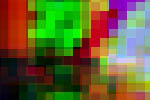 |
Plug-ins Revised
Dutch artist Peter Luining's Photoshop plug-ins work as odd additions to the existing Photoshop filters. Among other filters you will find a 'Michel Foucault filter' framing the antics of the filter as the struggle between self vs other, thus offering a warped perspective on the use of software as such. /TP |
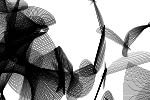 |
{Software} Structures
American artist Casey Reas used the wall drawings of Sol LeWitt as a catalyst for this project asking the question: 'Is the history of conceptual art relevant to the idea of software as art?'. Reas implemented 3 of Lewitt's drawings in software and derived 26 pieces of software in association with Jared Tarbell, Robert Hodgin, and William Ngan. /TP |
 |
Ghostwriter
Danish artist Sebastian Campion has created Ghostwriter, a browser-application that can be used to spam search engines with fake web searches. It can be used to fool surveillance software into believing that a sudden trend is taking place. It will be interesting to see which keyword fictions can arise from this project. /TP |
 |
Genomixer
Genomixer by British artist Stanza is based on his own DNA. The code in the DNA is then
used to generate visual effects and sound, code made by
code. /KP
|
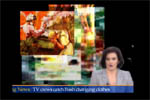 |
TooGle
TooGle by Italian artist
Fabio
Franchino is a parser that goes over the biggest
news source on the net http://news.google.com and uses
each word to find an image in http://images.google.com.
TooGle compiles it all into a small movie of nonsense
news. Check also the 2004 update 2TooGle. /KP
|
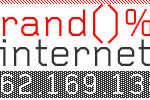 |
rand()%
rand()% is an internet
radio station streaming generative music. The project
was launched as a part of the Ultrasound festival in 2003
in Huddersfield, UK by Tom Betts and
Joe Gilmore. The participating artists
are too many to mention, but here's a schedule. /TP
|
 |
Anemone
Ben Fry's Anemone applet is an organism of sorts based on
the monitoring of web traffic on the website of the Aesthetics and Computation Group at MIT. Anemone grows in accordance to the user activity, growing thicker connections on popular routes and withering away as they go unused. /TP
|
 |
eBay Landscape
eBay Landscape by Italian
artist Carlo
Zanni is a visual representation of the eBay stock and
the CNN site. The mountains in the back show the fluctuation
of the eBAY stock and is updated every day when the NASDAQ
closes. In the bamboo branches you can see the image currently
showed on CNN's front page. /KP
|
 |
Arteroids
Arteroids is a game of words.
You use the web persona allocated to you - i.e. the word
'desire' - to shoot the sentences flying by or you get hit
by them. Once hit, the letters create new visual representations.
This work of digital poetry work was created by Jim
Andrews. /KP
|
|
 |
|
| |
|
| |
 wwwwwwwww. wwwwwwwww.
jodi.org
A truly classic net.art piece from Belgian/Dutch artist duo Jodi. If you were starting to feel like the internet was a warm and familiar space, then let Jodi show you what the aesthetics of computer errors are all about.
Specific Net.art found possible
One of Vuk Cosics (Slovenia) first websites made in connection to conference "Net.art per se" in 1996. It was made to replicate CNN's site at the time and can now can serve as a historical document of the ideas of early net.artists. Also read an interview with mr. Cosic here.
Artnode 1997
Courtesy of 'The Way Back Machine' at archive.org, we're able to take a look at the pioneering Danish organisation Artnode's site from the year 1997. This is definitly old school ... Check it out here. For reference, also try their current site www.artnode.org.
Computer art from the sixties
A. Michael Noll's first computer art was created at Bell Labs in Murray Hill, New Jersey during the Summer of 1962. This site shows some examples of his seriously old school computer art. Considering the time span, it is surprising how much the works are in tune with recent software art activities.
Young-hae
Chang Heavy Industries
Young-hae Changs visual poetry pieces
still serve as pointers to how net art can work amazingly
well without being interactive at all. Won The
Webby Awards art category in 2001.
Shredder
Mark Napiers classic alternative browser
that shreds the web pages into collages of mangled text and
graphics. Shred the web!
Mouchette
According to her site Mouchette is 13 years old and lives
in Amsterdam. If you give her your e-mail address she will
invite you to her birthday party. Worth checking out.
My
boyfriend came back from the war
The site shows Russian artist Olia Lialinas' original net.art
from 1996 and a number of remixes made by other artists, among
these are JoDi.
Vuk
Cosic
Slovenian Vuk Cosic was the man that (by accident) came across
the word net.art in an indecipherable e-mail he received back
in 1995. The only thing he could read in the mail was the
word net.art and after that he started using the word in newsgroups
etc.
äda'web
äda'web was one of the first net.art sites back
in the mid 1990's, but became inactive in 1998. The site is
still available and contains really super net.art.
Rhizome
Rhizome is an essential net art site. It offers art,
articles, book reviews, and lots of other things. It also
has a pile of mailing lists with, among others, one that sends
you a tip each day about net art.
Superbad.com
Superbad was one of the net.art works exhibited at the Whitney's
Biennial 2000. The site is full of funny stories, weird features
and lots of other things. The man behind it all (Ben Benjamin
is his name) often adds an extra front page, so this is a
site you should return to. |
|
|
| |
|
|



